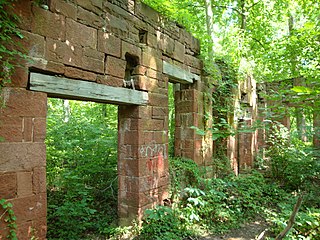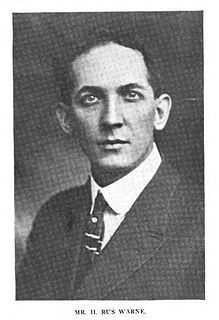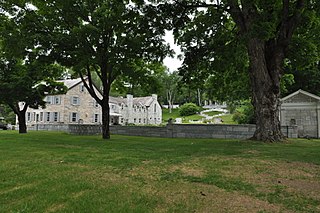
Charleston is the capital and most populous city of West Virginia. Located at the confluence of the Elk and Kanawha rivers, the city had a population of 51,400 at the 2010 census and an estimated population of 46,536 in 2019. The Charleston metropolitan area as a whole had an estimated 208,089 residents in 2019. Charleston is the center of government, commerce, and industry for Kanawha County, of which it is the county seat.

Branch House in Richmond, Virginia, was designed in 1916 by the firm of John Russell Pope as a private residence of financier John Kerr Branch (1865–1930) and his wife Beulah Gould Branch (1860–1952).

Tudor Place is a Federal-style mansion in Washington, D.C. that was originally the home of Thomas Peter and his wife, Martha Parke Custis Peter, a granddaughter of Martha Washington. The property, comprising one city block on the crest of Georgetown Heights, had an excellent view of the Potomac River.

Charles M. Goodman was an American architect who made a name for his modern designs in suburban Washington, D.C. after World War II. While his work has a regional feel, he ignored the colonial revival look so popular in Virginia. Goodman was quoted in the 1968 survey book Architecture in Virginia as saying that he aimed to "get away from straight historical reproduction."

The Trans-Allegheny Lunatic Asylum, subsequently the Weston State Hospital, was a Kirkbride psychiatric hospital that was operated from 1864 until 1994 by the government of the U.S. state of West Virginia, in the city of Weston. Weston State Hospital got its name in 1913 which was used while patients occupied it, but was changed back to its originally commissioned, unused name, the Trans-Allegheny Lunatic Asylum, after being reopened as a tourist attraction.

Agecroft Hall is a Tudor manor house and estate located at 4305 Sulgrave Road on the James River in the Windsor Farms neighborhood of Richmond, Virginia, United States. The manor house was built in the late 15th century, and was originally located in the Irwell Valley at Agecroft, Pendlebury, then in the historic county of Lancashire, England, but by the 20th century it was unoccupied and in a state of disrepair.

The Charles E. Roberts Stable is a renovated former barn in the Chicago suburb of Oak Park, Illinois, United States. The building has a long history of remodeling work including an 1896 transformation by famous American architect Frank Lloyd Wright. The stable remodel was commissioned by Charles E. Roberts, a patron of Wright's work, the same year Wright worked on an interior remodel of Roberts' House. The building was eventually converted into a residence by Charles E. White, Jr., a Wright-associated architect, sources vary as to when this occurred but the house was moved from its original location to its present site in 1929. The home is cast in the Tudor Revival style but still displays the architectural thumbprint of Wright's later work. The building is listed as a contributing property to a federally designated U.S. Registered Historic District.

The Washburn-Fair Oaks Mansion District is a historic district in the Whittier neighborhood of Minneapolis, Minnesota, United States, centered on Washburn-Fair Oaks Park. The city of Minneapolis designated a district bordered by Franklin Avenue, Fourth Avenue South, 26th Street East, and First Avenue South. A smaller district, listed on the National Register of Historic Places, includes seven mansions along and near 22nd Street East.

The Arden Park–East Boston Historic District is a neighborhood in the City of Detroit, Michigan, bounded on the west by Woodward Avenue, on the north by East Boston Boulevard, on the east by Oakland Avenue, and on the south by Arden Park Boulevard. The area is immediately adjacent to the much larger and better-known Boston-Edison Historic District, which is on the west side of Woodward Avenue, and also close to the Atkinson Avenue which is just south of Boston-Edison. There are 92 homes in the district, all on East Boston or Arden Park Boulevards. Arden Park Boulevard and East Boston Boulevard feature prominent grassy medians with richly planted trees and flowers. The setbacks of the homes are deep, with oversized lots. The district was listed on the National Register of Historic Places in 1982.

William Lee Stoddart (1868–1940) was an architect best known for designing urban hotels in the eastern United States. Although he was born in Tenafly, New Jersey, most of his commissions were in the South. He maintained offices in Atlanta and New York City.

Seneca Quarry is a historic site located at Seneca, Montgomery County, Maryland. It is located along the Chesapeake and Ohio Canal on the north bank of the Potomac River, just west of Seneca Creek. The quarry was the source of stone for two Potomac River canals: the Patowmack Canal on the Virginia side of Great Falls; and the C&O Canal, having supplied red sandstone for the latter for locks 9, 11, 15 - 27, and 30, the accompanying lock houses, and Aqueduct No. 1, better known as Seneca Aqueduct, constructed from 1828 to 1833.

Barnes-Wellford House is a historic home located at Charleston, West Virginia, United States. It was designed in the 1920s by English-born architect Fred Crowthers for Bernard Barnes, a leading Charleston businessman. The cottage size home is in the English Tudor style.

Laidley-Summers-Quarrier House, also known as Glenwood, is a historic home located at Charleston, West Virginia. It is a two-story gable roofed dwelling in the Greek Revival style and built in 1852.

Walton "Kip" Danforth Stowell was an American architect and historic preservationist, best known for his work for the U.S. National Park Service in designing visitors centers and interpretive exhibits in U.S. National Parks throughout the country. For most of his career, he worked at the Harpers Ferry Design Center which is responsible for architectural design and interpretive planning in National Parks.
Thomas Hope was an English-born American architect and house joiner, active primarily in Knoxville, Tennessee, during the late eighteenth and early nineteenth centuries. Trained in London, Hope moved to Knoxville in 1795, where he designed and built several of the city's earliest houses. At least two houses built by Hope— the Ramsey House (1797) in East Knoxville and Statesview in West Knoxville— are still standing, and have been listed on the National Register of Historic Places.

Harry Rus Warne was a Charleston, West Virginia-based architect.

The Manley-Lefevre House is a historic house at 1161 Dorset West Road in Dorset, Vermont. Built out of marble about 1820 and sympathetically enlarged 1908–1927, it is the centerpiece of a 100-acre (40 ha) farm estate that is now home to the Marble House Project, an arts organization offering residencies. The property was added to the National Register of Historic Places in 1990.



















